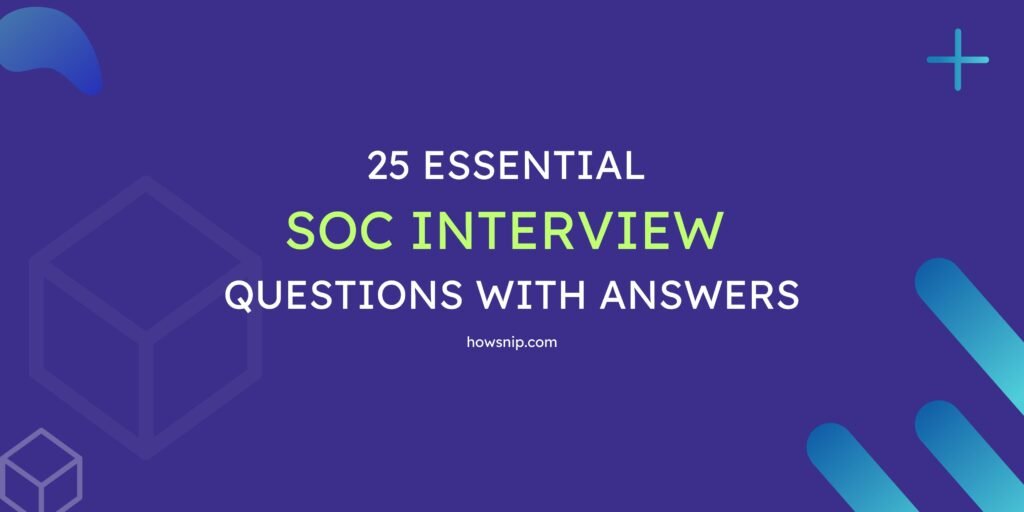SOC Interview preparation is crucial for cybersecurity professionals aiming to excel in Security Operations Center roles.
A Security Operations Centre (SOC) is a centralized unit that monitors, detects, analyzes, and responds to cybersecurity threats in real time. It plays a crucial role in protecting an organization’s digital assets, ensuring security incidents are handled efficiently.
This comprehensive guide answers 25 essential questions about Security Operations Centres (SOCs), covering everything from core functions and roles to tools, incident response, and modern challenges.
- What is a Security Operations Centre (SOC), and why is it important?
- What are the primary functions of a SOC?
- How does a SOC differ from a NOC (Network Operations Centre)?
- What are the key components of a SOC?
- What are the common cybersecurity threats that a SOC deals with?
- What tools and technologies are commonly used in a SOC?
- Can you explain the role of SIEM (Security Information and Event Management) in a SOC?
- What is threat intelligence, and how does it help SOC analysts?
- How do SOC teams detect and respond to security incidents?
- What is the difference between IDS and IPS?
- What steps are involved in incident response within a SOC?
- How do you prioritize security incidents in a SOC?
- What is threat hunting, and how does it differ from traditional monitoring?
- Can you explain the MITRE ATT&CK framework and its relevance to SOC operations?
- What are Indicators of Compromise (IoCs), and how are they used in a SOC?
- What are the different roles within a SOC team?
- What skills are required to be a SOC analyst?
- How does a SOC collaborate with other cybersecurity teams?
- What challenges do SOC analysts face in their daily operations?
- How do SOC teams ensure continuous improvement in their security posture?
- What is the role of automation and AI in modern SOC operations?
- How do SOC teams handle false positives in security alerts?
- What is the importance of log analysis in SOC operations?
- How do SOC teams deal with insider threats?
- What are the best practices for setting up and managing a SOC?
1. What is a Security Operations Centre (SOC), and why is it important?
A SOC is a centralized unit that monitors, detects, analyzes, and responds to various cybersecurity incidents in real time.
2. What are the primary functions of a SOC?
It includes threat detection and hunting, incident response (IR), continuous monitoring, log analysis, and security reporting.
3. How does a SOC differ from a NOC (Network Operations Centre)?
A SOC focuses on detecting and responding to security threats & incidents while a NOC ensures network performance and availability of IT infrastructure.
4. What are the key components of a SOC?
Components include people (analysts), processes (incident response), and technology (SIEM, IDS/IPS, firewalls).
5. What are the common cybersecurity threats that a SOC deals with?
Threats include malware, phishing, ransomware, DDoS attacks, insider threats, and zero-day vulnerabilities.
6. What tools and technologies are commonly used in a SOC?
Tools include SIEM solutions, IDS/IPS, firewalls, threat intelligence platforms (TIP), EDR, UEBA and SOAR solutions.
7. Can you explain the role of SIEM (Security Information and Event Management) in a SOC?
SIEM collects, correlates, and analyzes log data to identify and alert on potential security incidents. SIEM also enables proactive threat hunting by providing analysts with years of searchable, correlated security data.
Popular SIEM solutions include Splunk Enterprise Security, IBM QRadar, Microsoft Sentinel, Exabeam, Securonix, LogRhythm, and Elastic Security.
8. What is threat intelligence, and how does it help SOC analysts?
Threat intelligence provides contextual information on threats, helping analysts proactively detect and respond.
9. How do SOC teams detect and respond to security incidents?
They use tools (SIEM/EDR) and playbooks to identify anomalies, investigate alerts, in-depth analysis, contain threats, and restore systems.
10. What is the difference between IDS and IPS?
IDS detects and alerts on intrusions where as IPS detects and automatically blocks malicious traffic/activity.
11. What steps are involved in incident response within a SOC?
Essential steps include preparation, detection and identification, analysis (Triage), containment, eradication, recovery, and post-incident review.
12. How do you prioritize security incidents in a SOC?
Security Incidents are prioritized based on severity, impact, triage process, asset value, and threat level.
13. What is threat hunting, and how does it differ from traditional monitoring?
Threat hunting is proactive searching for cyber security threats, whereas monitoring relies on predefined alerts.
14. Can you explain the MITRE ATT&CK framework and its relevance to SOC operations?
MITRE ATT&CK is a knowledge base of adversary tactics and techniques used to map and improve detection strategies. By comparing implemented controls with MITRE ATT&CK, SOCs can identify and patch detection/response gaps, ensuring coverage across all attack stages.
15. What are Indicators of Compromise (IoCs), and how are they used in a SOC?
IoCs are forensic clues like IPs or hashes that help detect and track malicious activity.
Common Examples:
- Known bad IP addresses or domains
- Unusual outbound/inbound network traffic
- Anomalous administrator activity
- Unexplained new user accounts
- Suspicious changes to critical system or registry files
- Large numbers of failed logins or authentication attempts
16. What are the different roles within a SOC team?
Roles include Tier 1-3 Analysts, Incident Responders, Threat Hunters, Forensics Specialist/Investigator, Security Engineer and SOC Managers.
17. What skills are required to be a SOC analyst?
To be a SOC analyst, you need a soft skills include log analysis, threat detection, scripting, log parsing, network fundamentals, malware analysis, incident response, and knowledge of cybersecurity tools.
18. How does a SOC collaborate with other cybersecurity teams?
SOC works closely with IT, forensics, DevOps, and risk teams to coordinate responses and share threat intelligence.
19. What challenges do SOC analysts face in their daily operations?
SOC analysts face multiple challenges such as alert fatigue, high false positives rates, evolving threats, skill gaps, compliance demands, lack of automation and limited resources.
20. How do SOC teams ensure continuous improvement in their security posture?
Through regular and systematic reviews, training and cross skilling, red/blue team exercises, process refinements, and updating/optimizing the detection rules.
21. What is the role of automation and AI in modern SOC operations?
Automation helps with repetitive tasks and to increase efficiency, while AI aids in anomaly detection, threat prediction, behavioral analytics, alert enrichment and prioritization of alerts.
22. How do SOC teams handle false positives in security alerts?
SOC team handles false positives through fine-tuning the detection rules, use contextual analysis, and apply threat intelligence (TI) to validate the alerts.
23. What is the importance of log analysis in SOC operations?
Log analysis helps uncover suspicious patterns and trace the origin and impact of security threats and incidents.
24. How do SOC teams deal with insider threats?
They monitor user behavior, restrict access, and use tools like UEBA (User and Entity Behavior Analytics), PAM (Privileged Access Management) and DLP (Data Loss Prevention).
25. What are the best practices for setting up and managing a SOC?
Identify and define clear processes, using the right SOC tools such as SIEM/SOAR/EDR etc, staffing appropriately, and continuous improvement.


